国际市场营销(双语版)8.Place
国际市场营销双语课件
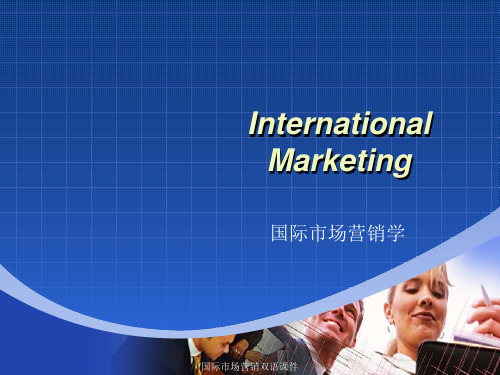
Marketing
• “an organizational function and a set of processes
for creating, communicating, and delivering value to customers and for managing customer relationships in ways that benefit the organization and its stakeholders”.
Company
Micro-environment
T
New discoveries and innovations Speed of technology transfer Rates of obsolescence Internet Information technology
国际市场营销双语课件
Five Forces Model
Technological factors • 科技因素
国际市场营销双语课件
Monopolies
legislation
Environmental
protection laws
Taxation policy
Employment laws
Government policy
Legislation
P
S
Demographics
International Marketing Mix (Product, pricing, promotion and place)
国际市场营销双语课件
Part 1,2 Part 3
Part 4
Some useful tools:
国际市场营销双语教学教案
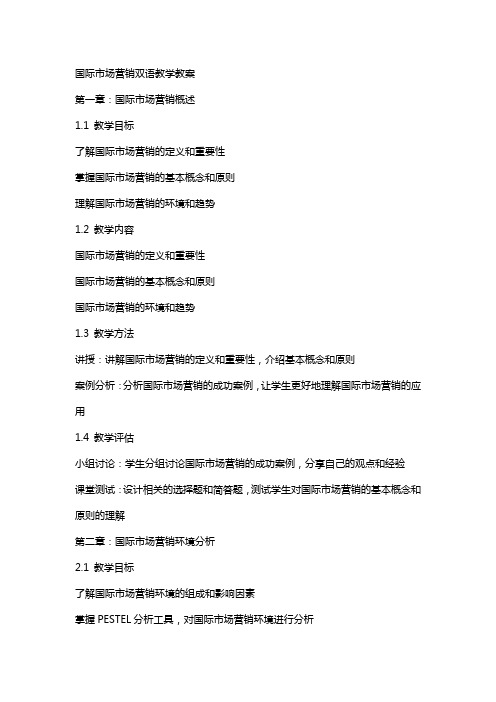
国际市场营销双语教学教案第一章:国际市场营销概述1.1 教学目标了解国际市场营销的定义和重要性掌握国际市场营销的基本概念和原则理解国际市场营销的环境和趋势1.2 教学内容国际市场营销的定义和重要性国际市场营销的基本概念和原则国际市场营销的环境和趋势1.3 教学方法讲授:讲解国际市场营销的定义和重要性,介绍基本概念和原则案例分析:分析国际市场营销的成功案例,让学生更好地理解国际市场营销的应用1.4 教学评估小组讨论:学生分组讨论国际市场营销的成功案例,分享自己的观点和经验课堂测试:设计相关的选择题和简答题,测试学生对国际市场营销的基本概念和原则的理解第二章:国际市场营销环境分析2.1 教学目标了解国际市场营销环境的组成和影响因素掌握PESTEL分析工具,对国际市场营销环境进行分析了解国际市场营销环境的发展趋势2.2 教学内容国际市场营销环境的组成和影响因素PESTEL分析工具的介绍和应用国际市场营销环境的发展趋势2.3 教学方法讲授:讲解国际市场营销环境的组成和影响因素,介绍PESTEL分析工具小组讨论:学生分组讨论国际市场营销环境的案例,运用PESTEL分析工具进行分析2.4 教学评估小组报告:学生分组进行报告,分享他们对国际市场营销环境案例的分析结果课堂测试:设计相关的问题,测试学生对PESTEL分析工具的应用和国际市场营销环境的发展趋势的理解第三章:国际市场营销策略3.1 教学目标了解国际市场营销策略的类型和选择掌握国际市场营销策略的基本原则和步骤了解国际市场营销策略的成功案例3.2 教学内容国际市场营销策略的类型和选择国际市场营销策略的基本原则和步骤国际市场营销策略的成功案例3.3 教学方法讲授:讲解国际市场营销策略的类型和选择,介绍基本原则和步骤案例分析:分析国际市场营销策略的成功案例,让学生更好地理解策略的应用3.4 教学评估小组讨论:学生分组讨论国际市场营销策略的成功案例,分享自己的观点和经验课堂测试:设计相关的问题,测试学生对国际市场营销策略的理解和应用能力第四章:国际市场营销渠道和物流4.1 教学目标了解国际市场营销渠道的类型和功能掌握国际市场营销渠道的选择和管理了解国际市场营销物流的流程和重要性4.2 教学内容国际市场营销渠道的类型和功能国际市场营销渠道的选择和管理国际市场营销物流的流程和重要性4.3 教学方法讲授:讲解国际市场营销渠道的类型和功能,介绍选择和管理的方法案例分析:分析国际市场营销渠道和物流的成功案例,让学生更好地理解应用4.4 教学评估小组讨论:学生分组讨论国际市场营销渠道和物流的成功案例,分享自己的观点和经验课堂测试:设计相关的问题,测试学生对国际市场营销渠道和物流的理解和应用能力第五章:国际市场营销推广和沟通5.1 教学目标了解国际市场营销推广的工具和策略掌握国际市场营销推广的基本原则和步骤了解国际市场营销沟通的重要性和方法5.2 教学内容国际市场营销推广的工具和策略国际市场营销推广的基本原则和步骤国际市场营销沟通的重要性和方法5.3 教学方法讲授:讲解国际市场营销推广的工具和策略,介绍基本原则和步骤案例分析:分析国际市场营销推广和沟通的成功案例,让学生更好地理解应用5.4 教学评估小组讨论:学生分组讨论国际市场营销推广和沟通的成功案例,分享自己的观点和经验课堂测试:设计相关的问题,测试学生对国际市场营销推广和沟通的理解和应用能力第六章:国际市场营销文化差异与适应6.1 教学目标了解不同文化对国际市场营销的影响掌握跨文化沟通的原则和策略了解如何适应不同文化的市场营销策略6.2 教学内容不同文化对国际市场营销的影响跨文化沟通的原则和策略适应不同文化的市场营销策略6.3 教学方法讲授:讲解不同文化对国际市场营销的影响,介绍跨文化沟通的原则和策略小组讨论:学生分组讨论文化差异对国际市场营销的影响,分享跨文化沟通的实践经验6.4 教学评估小组报告:学生分组进行报告,分享他们对文化差异对国际市场营销的影响的理解和跨文化沟通的实践经验课堂测试:设计相关问题,测试学生对不同文化对国际市场营销的影响和适应不同文化的市场营销策略的理解第七章:国际市场营销法律、伦理和社会责任7.1 教学目标了解国际市场营销中的法律和伦理问题掌握国际市场营销中的法律和伦理原则了解国际市场营销中的社会责任7.2 教学内容国际市场营销中的法律和伦理问题国际市场营销中的法律和伦理原则国际市场营销中的社会责任7.3 教学方法讲授:讲解国际市场营销中的法律和伦理问题,介绍法律和伦理原则小组讨论:学生分组讨论国际市场营销中的法律和伦理问题,分享对社会责任的理解7.4 教学评估小组报告:学生分组进行报告,分享他们对国际市场营销中的法律、伦理和社会责任的理解课堂测试:设计相关问题,测试学生对国际市场营销中的法律和伦理问题的理解以及对社会责任的认识第八章:国际市场营销计划和实施8.1 教学目标了解国际市场营销计划的结构和内容掌握国际市场营销计划的制定和实施步骤了解国际市场营销计划的评估和调整方法8.2 教学内容国际市场营销计划的结构和内容国际市场营销计划的制定和实施步骤国际市场营销计划的评估和调整方法8.3 教学方法讲授:讲解国际市场营销计划的结构和内容,介绍制定和实施的步骤案例分析:分析国际市场营销计划的案例,让学生更好地理解应用8.4 教学评估小组讨论:学生分组讨论国际市场营销计划的案例,分享自己的观点和经验课堂测试:设计相关问题,测试学生对国际市场营销计划的理解和应用能力第九章:国际市场营销案例分析9.1 教学目标了解国际市场营销案例分析的方法和技巧掌握国际市场营销案例分析的工具和步骤了解国际市场营销案例的成功经验和教训9.2 教学内容国际市场营销案例分析的方法和技巧国际市场营销案例分析的工具和步骤国际市场营销案例的成功经验和教训9.3 教学方法讲授:讲解国际市场营销案例分析的方法和技巧,介绍工具和步骤小组讨论:学生分组讨论国际市场营销案例,运用分析和技巧进行深入探讨9.4 教学评估小组报告:学生分组进行报告,分享他们对国际市场营销案例分析的理解和应用课堂测试:设计相关问题,测试学生对国际市场营销案例分析的方法和技巧的掌握第十章:国际市场营销的未来趋势10.1 教学目标了解国际市场营销的最新发展趋势掌握影响国际市场营销未来发展的因素了解国际市场营销的未来挑战和机遇10.2 教学内容国际市场营销的最新发展趋势影响国际市场营销未来发展的因素国际市场营销的未来挑战和机遇10.3 教学方法讲授:讲解国际市场营销的最新发展趋势,介绍影响未来发展的因素小组讨论:学生分组讨论国际市场营销的未来挑战和机遇,分享自己的观点和看法10.4 教学评估小组报告:学生分组进行报告,分享他们对国际市场营销最新发展趋势的理解和对未来挑战和机遇的认识课堂测试:设计相关问题,测试学生对国际市场营销的未来发展趋势的理解和认识重点和难点解析1. 教学目标:明确教学目标,确保教学内容能够满足学生的学习需求。
国际市场营销双语教程课件 cha8

• Management attitudes – Importance of exports – Overall price position of firm
• (1) What is dumping? Why do international companies use dumping strategies in select target markets?
• 什么是倾销?在选择目标市场时跨国企业为什么会使用倾销策略?
• (2) What are the different motivations behind a company when setting prices higher or lower in the home country?
• Market-differentiated pricing
– based on the dynamics of the marketplace
• changes in competition, exchange rates,osts
• Export-related costs
Framework
• 1.Pricing Decisions and Procedures • 2.Environment Related Challenges and Pricing Decisions • 3、 International Pricing Decisions
The Setting of Export Prices
• 什么属于灰色市场?目标市场上平行进口会怎样影响跨国企业的经营活动?
国际市场营销双语-精品.ppt

国际市场营销学
2
Marketing Promotion
国际市场营销学
3
内容简介 Learning Objectives
1. The changing face of U.S. business 2. The scope of the international marketing task
3. The increasing importance of global awareness
风险大, 难度大 Higher Risk and More Difficulties
国际市场营销学
9
1.2 国际市场营销与国际贸易
International Marketing & International Trade
国际贸易: 国家之间有形产品与无形服务的交换活动
Exchange of the visible products and invisible services among the nations 国与国之间分工的结果
Outcome of the International Labor Division
国际市场营销学
10
国际贸易与国际营销的共同点
What are in common for the both?
经营活动的目的:获取利润
Business Purpose: Earning profit 交换对象:商品和劳务
Marketing and International Marketing
Marketing is a social and managerial process by which individuals and groups obtain what they need and wue with others.
国际市场营销双语

4. Culture
5. PoliticalLegal
3. Economy 3. Economy
国际市场营销
International Marketing (双语教学)
山西财经大学 国际贸易学院 药朝诚
国际市场营销学
1
第一部分 国际市场营销导论
Guiding Theories of International Marketing
一、市场营销学的基础知识
Marketing Essentials
国际贸易、国际金融、跨国公司、现代技术 革命
国际市场营销学
17
可口可乐的应对策略
Coca-cola - from international to global
Before the mid-1990s
In charge of U.S. operations
President
In charge of international operations
贸易保护主义 Trade Protectionism
贸易区域集团化 Regional Economic Bloc
国际市场营销学
16
经济全球化
The Economic Globalization
经济全球化是指世界各国经济在生产、交换、 分配及消费四大环节的全球一体化,是资源 与生产要素在全球范围进行配置,使各国经 济彼此之间的联系及相互依赖日益加强,任 何一个国家或地区都不能与世界经济脱节而 单独生存和发展
国际市场营销学
8
国际市场营销的特点
Characteristics of the International Marketing
市场容量大,竞争激烈 Bigger market and Stronger Competition
国际市场营销双语课件
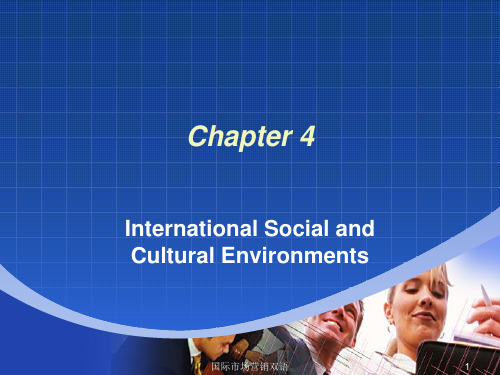
国际市场营销双语
15
、素质、行为、制度、形象 。
• 狭义的文化是指社会的意识形态以及与之相适应的礼仪制 度、组织结构、行为方式等物化的精神。
国际市场营销双语
6
4.1.3 文化的基本特征
• 1. 文化的中心 • 2. 文化管理的方式 • 3. 文化的首要任务
国际市场营销双语
7
4.1.4 文化的要素
• 从组织的角度来看,美国学者彼得斯和沃特曼认为有7种 基本要素:战略(Strategy)、结构(Structure)、体制 (System)、人员(Staff)、技能(Skill)、行为方式 (Style)、共同价值观(Shared Value)。其中,前3个要素
• 文化的要素 • 文化的变迁 • 各国的商务习惯
国际市场营销双语
4
4.1.1 文化的基础
• 作为一名营销者,若要了解一个社会的行为及其基 本态度,就必须掌握关于该社会的一些地理及历史 知识。
• 不同的地理环境和不同的历史背景就会形成特定的 亚文化,特定的亚文化必然会影响消费群体和商业 模式的形成。
国际市场营销双语
11
4.1.6 各国的商务习惯
• 美国 ,“赚钱是这个国家的主要目标。美国人看重金钱 与其说是为了生存,不如说是作为一生成就的证明” 。
• 日本,商界是最注重谦恭的。 • 韩国,商人尊重其长辈可以获得其好感。
国际市场营销双语
12
4.2 Social Environment of International Marketing
国际市场营销双语
5
4.1.2 文化的涵义
• 广义的文化是指人类在社会历史实践过程中创造的物质财 富和精神财富的总和。
市场营销 (双语) Chapter 8 Marketing Engineering

8.1 Origin and Development of the Marketing Engineering
The marketing engineering is a systematic one, which can raise the correctness of the decision making and the benefits of the marketing input by way of integrating marketing knowledge, its data, issues, decision-making models, management systems, information and case banks, etc. so as to help the marketing decision-maker realize the streamlining, quantification, science, and normalization of the decision. Its origin and development have seen the following stages: (1) Application of the mathematic models in the marketing, which is represented by the book “Quantitative Technologies in Analyzing the Marketing” written by R. Frank, etc.; (2) Management information systems (1965). They are mainly embodied in the “Design of the Marketing Neurological Centre for the Enterprise” written by Philip Kotler;
国际市场营销英语
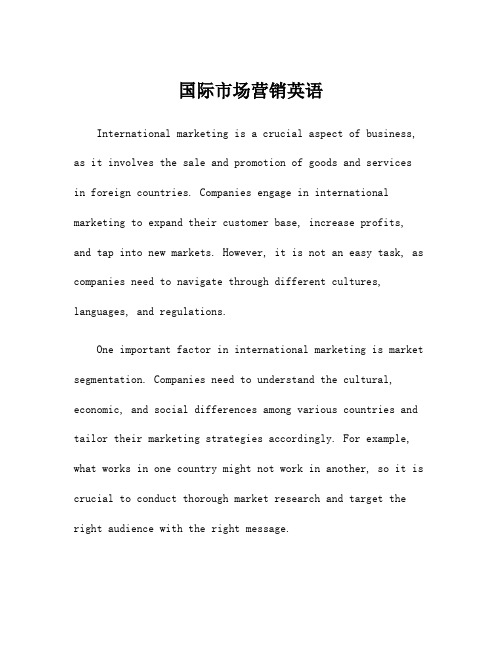
国际市场营销英语International marketing is a crucial aspect of business, as it involves the sale and promotion of goods and servicesin foreign countries. Companies engage in international marketing to expand their customer base, increase profits, and tap into new markets. However, it is not an easy task, as companies need to navigate through different cultures, languages, and regulations.One important factor in international marketing is market segmentation. Companies need to understand the cultural, economic, and social differences among various countries and tailor their marketing strategies accordingly. For example, what works in one country might not work in another, so it is crucial to conduct thorough market research and target the right audience with the right message.Another key aspect of international marketing is branding. Companies need to develop a strong and consistent brand image that resonates with consumers across different countries.This requires careful consideration of cultural differences and preferences, as well as the adaptation of branding and marketing materials to suit each target market.Moreover, pricing and distribution are critical components of international marketing. Companies need to consider factors such as exchange rates, import/export duties, and local pricing strategies when setting prices for their products. Additionally, they need to develop efficient distribution channels to ensure that their products reach consumers in a timely and cost-effective manner.In the digital age, online marketing has become increasingly important in international marketing. Companies can leverage social media, search engine optimization, and online advertising to reach global audiences and engage withpotential customers in different countries. However, they need to be mindful of cultural nuances and language barriers when crafting online marketing campaigns.In conclusion, international marketing is a complex and challenging endeavor, but it offers great opportunities for companies to expand their business and reach new customers around the world. By understanding and adapting to the unique characteristics of each target market, companies can develop successful international marketing strategies and achieve sustainable growth in the global marketplace.。
国际市场营销(双语)课程教学大纲

《国际市场营销》(双语)课程教学大纲一、课程简介课程类别:专业课开课单位:工商管理系授课对象:本科市场营销专业学时与学分:36学时;2学分使用教材:Warren J.Keegan and Mark C.Green,《全球营销学》第四版(Global Marketing, Fouth Edition),中国人民大学出版社,2005年9月参考教材:[美]菲利普·R·凯特奥拉,《国际营销》(International Marketing),机械工业出版社,2003年1月二、教学目的与教学要求:1.本课程教学目的是:介绍由经济与金融、社会与文化、政治与法律等方面构成的全球商务环境,进而从环境和战略的角度讨论企业的全球营销策略和方式;介绍一整套先进的概念和分析工具(如价值链分析框架、产品贸易周期模型、国际产品生命周期理论、管理导向类别框架、杠杆理论、资源外取理论、全球战略伙伴关系、全球当地化整合原理和国家竞争优势分析框架等);启迪和帮助学生在全球营销中把握发展战略,成功创作和实施4P(产品、价格、分销、促销)策略组合的途径;帮助学生运用英语学习专业知识,提高学生地英语使用能力。
2.教学要求:①对于教师,具体的要求有:双语授课,英语授课课时比例大约50%;使用原版英文教材;理论讲解与案例讨论相结合;②对于学生,具体的要求有:必须先修完“市场营销”;英语达到4级水平3.考试方式和成绩计算:采用全英文考试;平时成绩占10%,期中占20%,期末占70%。
第一章Introduction to Global Marketing学时:2 周,共 3 学时教学重点:全球化和全球本地化的概念、全球营销的管理取向、影响全球一体化和全球营销的因素。
教学难点:全球营销的管理取向、影响全球营销的因素。
教学内容:1.Overview of Marketing(1)Competitive advantage(2)Globalization(3)Global Industries2.Global Marketing: What It Is and What It Isn’t3.The Importance of Global Marketing4.Management Orientations(1)Ethnocentric Orientation(2)Polycentric Orientation(3)Regiocentric(4)Geocentric orientations5.Forces Affecting Global Integration and Global Marketing(1)Driving Forces(2)Restraining Forces6.Outline of this book本章考点:1.What are the basic goals of marketing? Are these goals relevant to globalmarketing?2.What is mean by “global localization”? Is Coca-Cola a global product? Explain.3.Describe some of the global marketing strategies available to companies. Giveexamples of companies that use the different strategies.4.How do the global marketing strategies of Harley-Davidson and Toyota differ?5.Describe the difference between ethnocentric, polycontric, regiocentric, andgeocentric management orientations.6.Identify and briefly describe some of the forces that have resulted in increasedglobal integration and the growing importance of global marketing.7.Define leverage and explain the different types of leverage utilized by companieswith global operations.本章参考文献:1.Warren J.Keegan and Bodo B.Schlegelmilch,《Global Marketing Management: AEuropeanPerspective》, Pearson Education Limited,20012.菲利普 R.凯特奥拉,约翰 L.格雷厄姆,《国际营销》,中国人民大学出版社,20053.菲利普 R.凯特奥拉,约翰 L.格雷厄姆,《国际市场营销学》, 机械工业出版社,20054.马萨基.科塔比,克里斯蒂安.赫尔森,《全球营销管理》,中国人民大学出版社,20055.闫国庆,沈哲,孙琪,陈林兴,《国际市场营销学》,清华大学出版社,20046.甘碧群,《国际市场营销学》,武汉大学出版社,20027.王文举,张启明,《国际市场营销》,中国统计出版社,2003第二章The Global Economic Environment学时:2 周,共 4学时教学重点:国家发展阶段,产品饱和度,经济合作协议教学难点:国家发展阶段,国际结算,国际金融教学内容:1.The world Economy: An overview2.Economic systems(1)Market Capitalism(2)Centrally Planned Socialism(3)Centrally Planned Capitalism and Market Socialism3.Stages of Market Development(1)Low-Income Countries(2)Lower-Middle-Income Countries(3)Upper-Middle-Income Countries(4)Marketing Opportunities in LDCs and Developing Countries(5)High-Income Countries(6)The Triad(7)Marketing Implications of the stages of Development4.Banlance of Payments5.World Trade in Merchandise and Services6.Overview of International Finance(1)Managed Dirty Float(2)Foreign Exchange Market Dynamics(3)Purchasing Power Parity(4)Economic Exposure(5)Managing Exchange Rate Exposure本章考点:1.Explain the difference between market capitalism, centrally planned capitalism,centrally planned socialism, and market socialism. Give an example of a country that illustrates each types of system.2.What is a BEM? Identify the BEMs according to their respective stages of economicdevelopment.3. A manufacture of satellite dishes is assessing the world market potential forhis products. He asks you if he should consider developing countries as potential markets. How would you advise him?4.Turn to the Index of Economic Freedom (Table 2-1) and identify where the BEMsare ranked. What does the result tell you in terms of the relevance of the index to global marketers?本章参考文献:1.Warren J.Keegan and Bodo B.Schlegelmilch,《Global Marketing Management: AEuropeanPerspective》, Pearson Education Limited,20012.菲利普 R.凯特奥拉,约翰 L.格雷厄姆,《国际营销》,中国人民大学出版社,20053.菲利普 R.凯特奥拉,约翰 L.格雷厄姆,《国际市场营销学》, 机械工业出版社,20054.马萨基.科塔比,克里斯蒂安.赫尔森,《全球营销管理》,中国人民大学出版社,20055.闫国庆,沈哲,孙琪,陈林兴,《国际市场营销学》,清华大学出版社,20046.甘碧群,《国际市场营销学》,武汉大学出版社,20027.王文举,张启明,《国际市场营销》,中国统计出版社,2003年第三章Social and Cultural Environments学时:2 周,共3学时教学重点:高背景文化和低背景文化、马斯洛的需求层次说、霍夫斯泰德德文化类型说以及自参考标准教学难点:霍夫斯泰德文化类型说、自参考标准和文化差异和相似性教学内容:1.High- and Low-Context Cultures2.Hofstede’s Cultural Typology3.The Self-Reference Criterion and Perception4.Diffusion Theory+(1)The Adoption Process(2)Characteristics of Innovations(3)Adopter Categories(4)Diffusion of Innovations in Pacific Rim Countries5.Marketing Implications of Social and Cultural Environments本章考点:1.What are some of the elements that make up culture? How do these find expressionin your native culture?2.What is the difference between a low-context culture and a high-context culture?Give an example of a country that is an example of each type and provide evidence for your answer.3.How can Hofstede’s cultural typologies help Western marketers better understandAsian culture?4.Explain the self-reference criterion. Go to the library and find examples ofproduct failures that might have been avoided through the application of the SRC.pare and contrast USA and Japan in terms of traditions and organizationalbehavior and norms.本章参考文献:1.Warren J.Keegan and Bodo B.Schlegelmilch,《Global Marketing Management: AEuropean Perspective》, Pearson Education Limited,20012.菲利普 R.凯特奥拉,约翰 L.格雷厄姆,《国际营销》,中国人民大学出版社,20053.菲利普 R.凯特奥拉,约翰 L.格雷厄姆,《国际市场营销学》, 机械工业出版社,20054.马萨基.科塔比,克里斯蒂安.赫尔森,《全球营销管理》,中国人民大学出版社,20055.闫国庆,沈哲,孙琪,陈林兴,《国际市场营销学》,清华大学出版社,20046.甘碧群,《国际市场营销学》,武汉大学出版社,20027.王文举,张启明,《国际市场营销》,中国统计出版社,2003第四章The Legal and Regulatory Environments of Global Marketing学时:2 周,共 3 学时教学重点:普通法和成文法、专利和商标、许可贸易、法庭裁决和仲裁方式、管理环境教学难点:专利和商标、许可贸易、各种政府和民间组织教学内容1.The Legal Environment(1)Common Law Versus Civil Law(2)Sidestepping Legal Problems: Important Business Issues(3)Conflict Resolution, Dispute Settlement, and Litigation2.The Regulatory Environment(1)Regional Economic Organizations: The European Union Example本章考点:1.What is sovereignty? What is it an important consideration in the politicalenvironment of global marketing?2.Describe some of the sources of political risk. Specially, what forms canpolitical risk take?3.Briefly describe some of the differences between the legal environment of acountry that embraces common law and one that observes civil law.4.Global marketers can avoid legal conflicts by understanding the reasonsconflicts arise in the first place. Identify and describe several legal issues that relate to global commerce.5.“See you in court” is one way to respond when legal issues arise. What otherapproaches are possible?本章参考文献:1.Warren J.Keegan and Bodo B.Schlegelmilch,《Global Marketing Management: AEuropean Perspective》, Pearson Education Limited,20012.沈钺,《全球营销学》,武汉大学出版社,20043.菲利普 R.凯特奥拉,约翰 L.格雷厄姆,《国际市场营销学》, 机械工业出版社,20054.马萨基.科塔比,克里斯蒂安.赫尔森,《全球营销管理》,中国人民大学出版社,20055.闫国庆,沈哲,孙琪,陈林兴,《国际市场营销学》,清华大学出版社,2004年6.甘碧群,《国际市场营销学》,武汉大学出版社,20027.王文举,张启明,《国际市场营销》,中国统计出版社,2003第五章Global Information Systems and Market Research学时:2 周,共 3 学时教学重点:市场信息的来源、正式的市场调查研究步骤教学难点:市场调查研究步骤,一体化的市场信息收集教学内容:rmation Technology for Global Marketingrmation subject agenda and environmental scanning modes3.Sources of market information4.Formal market research(1)Step1: Identify the Information Requirement(2)Step2: Problem Definition---Overcoming the SRC(3)Step3: Choose Unit of Analysis(4)Step4: Examine Data Availability(5)Step5: Assess Value of Research(6)Step6: Research Design(7)Step7: Analyzing Data(8)Step8: Presenting the Findings(9)Headquarter’s Control of Marketing Research(10)An Integrated Approach to Information Collection本章考点:1.Explain two information technology puts powerful tools in the hands of globalmarketers.2.What are the different modes of information acquisition? Which is the mostimportant for gathering strategic information?3.Outline the basic steps of the market research process.4.What is the difference between existing, latent, and incipient demand? How mightthese differences affect the design of a marketing research project?5.Describe some of the analytical techniques used by global marketers. When isit appropriate to use each technique?本章参考文献:1.Warren J.Keegan and Bodo B.Schlegelmilch,《Global Marketing Management: AEuropean Perspective》, Pearson Education Limited,20012.沈钺,《全球营销学》,武汉大学出版社,20043.菲利普 R.凯特奥拉,约翰 L.格雷厄姆,《国际市场营销学》, 机械工业出版社,20054.马萨基.科塔比,克里斯蒂安.赫尔森,《全球营销管理》,中国人民大学出版社,20055.闫国庆,沈哲,孙琪,陈林兴,《国际市场营销学》,清华大学出版社,2004年6.甘碧群,《国际市场营销学》,武汉大学出版社,20027.王文举,张启明,《国际市场营销》,中国统计出版社,20038.王海忠,《全球营销:规则、指南、案例》,企业管理出版社,2002第六章Segmentation, Targeting, and Positioning学时:2 周,共 3 学时教学重点:全球细分、选择目标市场、全球定位、产品市场决策、高科技和高感性定位教学难点:选择目标市场及定位、高科技和高感性定位教学内容:1.Global Market Segmentation(1)Demographic Segmentation(2)Psychographic Segmentation(3)Behavior Segmentation(4)Benefit Segmentation(5)Ethnic Segmentation2.Assessing Market Potential and Choosing Target Markets or Segments(1)Current Segment Size and Growth Potential(2)Potential Competition(3)Feasibility and Compatibility(4)A Framework for selecting Target Markets3.Product-Market Decisions4.Target Market Strategy Options(1)Standardized Global Marketing(2)Concentrated Global Marketing(3)Differentiated Global Marketing5.Positioning(1)Attribute or benefit(2)Quality and Price(3)Use or User(4)Competitor(5)Global, Foreign, and Local Consumer Culture Positioning本章考点:1.differentiate the five basic segmentation strategies. Give an example of acompany that has used each one.2.Explain the difference between segmenting and targeting.pare and contrast standardized, concentrated, and differentiated globalmarketing. Illustrate each strategy with an example from a global company.4.What is positioning? Identify the different positioning strategies presentedin the chapter and give examples of companies or products that illustrate each.5.What is global consumer culture positioning? What other strategic positioningchoices do global marketers have?6.What is high-touch product? Explain the difference between high-tech productpositioning and high-touch product positioning. Can some products be positioned using both strategies? Explain.本章参考文献:1. Warren J.Keegan and Bodo B.Schlegelmilch,《Global Marketing Management: AEuropean Perspective》, Pearson Education Limited,20012.沈钺,《全球营销学》,武汉大学出版社,20043.菲利普 R.凯特奥拉,约翰 L.格雷厄姆,《国际市场营销学》, 机械工业出版社,20054.马萨基.科塔比,克里斯蒂安.赫尔森,《全球营销管理》,中国人民大学出版社,20055.闫国庆,沈哲,孙琪,陈林兴,《国际市场营销学》,清华大学出版社,2004年6.甘碧群,《国际市场营销学》,武汉大学出版社,20027.王文举,张启明,《国际市场营销》,中国统计出版社,20038.王海忠,《全球营销:规则、指南、案例》,企业管理出版社,2002第七章Global Market Entry Strategies:Licensing, Investment, and Strategic Alliances学时:2 周,共4 学时教学重点:许可和合营、市场扩张战略、投资扩张和战略联盟教学难点:全球战略合作伙伴概念、市场扩张战略教学内容:1.LicensingSpecial Licensing Arrangements2.Investment(1)Joint Ventures(2)Investment via Ownership or Equity Stake3.Global Strategic Partnerships4.The Nature of Global Strategic Partnerships(1)Success Factors(2)Alliances with Asian Competitors(3)CFM International, GE, and Snecma: A Successful Story(4)AT&T and Olivertti: A Failure(5)Boeing and Japan: A Failure(6)International Partnerships in Developing Countries5.Cooperative Strategies in Japan: Keiretsu6.Cooperative Strategies in South Korea: Chaebol7.Twenty-First Century Cooperative Strategies: Targeting the Digital Future8.Market Expansion Strategies本章考点:1.What are the advantages and disadvantages of using licensing as a market entrytool? Give examples of companies from different countries that use licensing as a global marketing strategy.2.What is foreign direct investment? What forms can FDI take?3.Do you agree with Ford’s decision to acquire Jaguar? What was more valuableto Ford---the physical assets or the name?4.What is meant by the phrase global strategic partnership? In what ways does thisform of market entry strategy differ from more traditional forms such as joint ventures?5.What are Keiretsu? How does this form of industrial structure affect companiesthat compete with Japan or that are trying to enter the Japanese market?6.Which Strategic options for market entry or expansion would a small company belikely to pursue? A large company?本章参考文献:1.Warren J.Keegan and Bodo B.Schlegelmilch,《Global Marketing Management: AEuropean Perspective》, Pearson Education Limited,20012.沈钺,《全球营销学》,武汉大学出版社,20043.菲利普 R.凯特奥拉,约翰 L.格雷厄姆,《国际市场营销学》, 机械工业出版社,20054.马萨基.科塔比,克里斯蒂安.赫尔森,《全球营销管理》,中国人民大学出版社,20055.闫国庆,沈哲,孙琪,陈林兴,《国际市场营销学》,清华大学出版社,2004年6.甘碧群,《国际市场营销学》,武汉大学出版社,20027.王文举,张启明,《国际市场营销》,中国统计出版社,20038.王海忠,《全球营销:规则、指南、案例》,企业管理出版社,20029.吴声功,《跨国公司经营管理》,上海人民出版社,2003第八章Product and Brand Decisions学时:1 周,共 2 学时教学重点:产品和品牌概念、原产国因素、地域扩张、全球营销中的新产品开发教学难点:地域扩张、全球营销中的新产品开发教学内容:1.Basic product and brand concepts(1)Product Types(2)Brands(3)Local Products and Brands(4)International Products and Brands(5)Global Products and Brands(6)Global Brand Development(7)Local Versus Global Products and Brands: A Need-Based Approach2.Country of origin as brand element3.Packaging(1)Labeling(2)Aesthetics4.Product warranties5.Extend, Adapt, Great: strategic alternatives in global marketing(1)Strategy1: Product-Communication Extension(2)Strategy2: Product Extension-Communication Adaptation(3)Strategy3: Product Adaptation-Communication Extension(4)Strategy4: Product-Communication Adaptation(5)Strategy5: Product Invention(6)How to Choose a strategy6.New products in global marketing(1)Identifying New-Product Ideas(2)New-Product Development(3)The International New-Product Department(4)Testing New Products本章考点:1.What is the difference between a product and a brand?2.How do local, international, and global products differ? Cite examples3.What are some of the elements that make up a brand? Are these elements tangibleor intangible?4.What criteria should global marketers consider when making product designdecisions?5.How can buyer attitudes about a product’s country of origin affect marketingstrategy?6.Identify several global brands. What are some of the reasons for the globalsuccess of the brands you chose?7.Briefly describe various combinations of product-communication strategiesavailable to global marketers. When is it appropriate to use each?本章参考文献:1.Warren J.Keegan and Bodo B.Schlegelmilch,《Global Marketing Management: AEuropean Perspective》, Pearson Education Limited,20012.沈钺,《全球营销学》,武汉大学出版社,20043.菲利普 R.凯特奥拉,约翰 L.格雷厄姆,《国际市场营销学》, 机械工业出版社,20054.马萨基.科塔比,克里斯蒂安.赫尔森,《全球营销管理》,中国人民大学出版社,20055.闫国庆,沈哲,孙琪,陈林兴,《国际市场营销学》,清华大学出版社,2004年6.甘碧群,《国际市场营销学》,武汉大学出版社,20027.杨建新,《产品生命周期评价方法及应用》,气象出版社,20028.胡树华,《产品开发设计的功能成本分析》,科学出版社,20019.李倩茹,《新产品开发、定位和销售》,广州经济出版社,2002第九章Pricing Decisions学时:1 周,共 2学时教学重点:全球定价目标和策略、影响定价决策的环境因素、灰色市场、倾销、转移定价、反向贸易教学难点:全球定价策略、灰色市场、倾销、抵销、反向贸易教学内容:1.Basic pricing concepts2.Global pricing objectives and strategies(1)Market Skimming and Financial Objectives(2)Penetration Pricing and Nonfinancial Objectives(3)Companion Product “Razors and Blades” Pricing(4)Target Costing(5)Calculating Prices: Cost-based Pricing and Price Escalation(6)Terms of Sale3.Environment influences on pricing decisions(1)Currency Fluctuations(2)Inflationary Environment(3)Government Controls, Subsidies, and Regulations(4)Competitive Behavior(5)Using Sourcing as a Strategic Pricing Tool4.Global pricing: three policy alternatives(1)Extension or Ethnocentric(2)Adaptation or Polycentric(3)Geocentric5.Gray market goods6.Dumping7.Price fixing8.Transfer pricing(1)Tax Regulations and Transfer Prices(2)Sales of Tangible and Intangible Property(3)Competitive Pricing(4)Importance of Section 482 Regulations9.Countertrade(1)Barter(2)Counterpurchase(3)Offset(4)Compensation Trading(5)Switch Trading本章考点:1.What are the basic factors that affect price in any market? What considerationsenter into the pricing decision?2.Define the various types of pricing strategies and objectives available to globalmarketers.3.Identify some of the environmental constraints on global pricing decisions.4.Why do price differences in world markets often lead to gray marketing?5.What is dumping? Why was dumping such an important issue during the Uruguay Roundof GATT negotiations?6.What is transfer price? Why is it an important issue for companies with foreignaffiliates? Why did transfer pricing in Europe take on increased importance in 1999?7.What is the difference between ethnocentric, polycontric, and geocentric pricingstrategies? Which one would you recommend to a company that has global market aspirations?pare and contrast the different forms of countertrade.本章参考文献:1.Warren J.Keegan and Bodo B.Schlegelmilch,《Global Marketing Management: AEuropean Perspective》, Pearson Education Limited,20012.沈钺,《全球营销学》,武汉大学出版社,20043.菲利普 R.凯特奥拉,约翰 L.格雷厄姆,《国际市场营销学》, 机械工业出版社,20054.马萨基.科塔比,克里斯蒂安.赫尔森,《全球营销管理》,中国人民大学出版社,20055.闫国庆,沈哲,孙琪,陈林兴,《国际市场营销学》,清华大学出版社,2004年6.甘碧群,《国际市场营销学》,武汉大学出版社,20027.王文举,张启明,《国际市场营销》,中国统计出版社,20038.王海忠,《全球营销:规则、指南、案例》,企业管理出版社,20029.吴声功,《跨国公司经营管理》,上海人民出版社,2003第十章Global Marketing Channels and Physical Distribution学时:1 周,共 2 学时教学重点:分销渠道管理、建立和保持渠道中介、全球零售业、物流管理教学难点:全球零售渠道、物流管理教学内容:1.Channel objectives2.Distribution channels :terminology and structure(1)Consumer Products and Services(2)Industrial Products3.Establishing channels and working with channel intermediaries4.Global retailing5.Innovation in global retailing6.Physical distribution, supply chains, and logistics management(1)Order Processing(2)Warehousing(3)Inventory Management(4)Transportation(5)Logistics Management: A Brief Case Study本章考点:1.In what ways can channel intermediaries create utility for buyers?2.What factors influence the channel structures and strategies available to globalmarketers?3.What is cherry picking? What approaches can be used to deal with this problem?pare and contrast the typical channel structures for consumer products andindustrial products.5.Identify the different forms of retailing and cite an example of each form.Identify retailers from as many different countries as you can.6.Identify the four retail market expansion strategies discussed in the text. Whatfactors determine the appropriable mode?7.What special distribution challenges exist in Japan? What is the best way fora non-Japanese company to deal with these challenges?本章参考文献:1.Warren J.Keegan and Bodo B.Schlegelmilch,《Global Marketing Management: AEuropean Perspective》, Pearson Education Limited,20012.沈钺,《全球营销学》,武汉大学出版社,20043.菲利普 R.凯特奥拉,约翰 L.格雷厄姆,《国际市场营销学》, 机械工业出版社,20054.马萨基.科塔比,克里斯蒂安.赫尔森,《全球营销管理》,中国人民大学出版社,20055.闫国庆,沈哲,孙琪,陈林兴,《国际市场营销学》,清华大学出版社,2004年6.甘碧群,《国际市场营销学》,武汉大学出版社,20027.李飞,《分销渠道》,清华大学出版社,20038.邹树彬,《分销渠道管理》,广东经济出版社,2000第十一章Global Marketing Communications Decisions:Advertising and Public Relations学时:1 周,共2学时教学重点:全球广告、全球媒体决策、公共关系和公众度教学难点:全球广告、世界各地的公关差异教学内容:1.Global advertisingGlobal Advertising Content: The “Standardization”versus “adaptation”Debate2.Advertising agency: organizations and brandsSelecting an Advertising Agency3.Creating global advertising(1)Art Directors and Art Direction(2)Copy(3)Cultural Considerations4.Global media decisions(1)Media vehicles and expenditures(2)Media Decisions5.Public relations and publicity(1)The Growing Role of Public Relations in Global Marketing(2)Communications(3)How public relations practices differ around the world本章考点:1.In what ways can global brands and global advertising campaigns benefit acompany?2.How does the “standardized versus localized” debate apply to advertising?3.What is the difference between an advertising appeal and creative execution?4.When creating advertising for world markets, what are some of the issues thatart directorsand copywriters should take into account?5.How do the media options available to advertisers vary in different parts ofthe world? What can advertiser do to cope with media limitations in certain countries?6.How does public relations differ from advertising? Why is PR especially importantfor global companies?7.What are some of the ways public relations practices vary in different partsof the world?本章参考文献:1.Warren J.Keegan and Bodo B.Schlegelmilch,《Global Marketing Management: AEuropean Perspective》, Pearson Education Limited,20012.沈钺,《全球营销学》,武汉大学出版社,20043.菲利普 R.凯特奥拉,约翰 L.格雷厄姆,《国际市场营销学》, 机械工业出版社,20054.马萨基.科塔比,克里斯蒂安.赫尔森,《全球营销管理》,中国人民大学出版社,20055.闫国庆,沈哲,孙琪,陈林兴,《国际市场营销学》,清华大学出版社,2004年6.甘碧群,《国际市场营销学》,武汉大学出版社,20027.王文举,张启明,《国际市场营销》,中国统计出版社,20038.王海忠,《全球营销:规则、指南、案例》,企业管理出版社,20029.吴声功,《跨国公司经营管理》,上海人民出版社,200310.张映红,《公共关系管理》,北京经济学院出版社,200311.周广华,《促销管理实战》,广东经济出版社,2003第十二章Strategic Elements of Competitive Advantage 学时:1 周,共2学时教学重点:行业分析(影响竞争的因素)、竞争优势、全球竞争和国家竞争优势教学难点:竞争优势、全球竞争和国家竞争优势教学内容:1.Industry analysis: forces influencing competition(1)Threat of New Entrants(2)Threat of Substitute Products(3)Bargaining Power of Buyers(4)Bargaining Power of Supplier(5)Rivalry Among Competitorspetitive advantage(1)Generic Strategies for Creating Competitive Advantage(2)The Flagship Firm: The Business Network with Five Partners(3)Creating Competitive Advantage via Strategic Intent3.Global competition and national competitive advantage(1)Demand Conditions(2)Related and Supporting Industries(3)Firm Strategy, Structure, and Rivalry(4)Chance(5)Government4.Current issues in competitive advantage本章考点:1.How can a company measure its competitive advantage? How does a firm know ifit is gaining or losing competitive advantage? Cite a global company and its source of competitive advantage.2.Outline Porter`s five forces model of industry competition. How are the variousbarriers to entry relevant to global marketing?3.How does the five partners, or flagship model, developed by Rugman and D`Avenidiffer from Porter`s five forces model?4.Give an example of company that illustrates each of the four generic strategiesthat can lead to competitive advantage: overall cost leadership, cost focus, differentiation, and differentiation focus.5.Briefly describe Hamel and Prahalad`s framework for competitive advantage.6.How can a nation achieve competitive advantage?7.According to current research on competitive advantage, what are some of theshortcomings of Porter`s models?8.What is the connection, if any, between national competitive advantage andcompany competitive advantage? Explain and discuss.本章参考文献:1.Warren J.Keegan and Bodo B.Schlegelmilch,《Global Marketing Management: AEuropean Perspective》, Pearson Education Limited,20012.沈钺,《全球营销学》,武汉大学出版社,20043.菲利普 R.凯特奥拉,约翰 L.格雷厄姆,《国际市场营销学》, 机械工业出版社,20054.马萨基.科塔比,克里斯蒂安.赫尔森,《全球营销管理》,中国人民大学出版社,20055.闫国庆,沈哲,孙琪,陈林兴,《国际市场营销学》,清华大学出版社,2004年6.甘碧群,《国际市场营销学》,武汉大学出版社,20027.王文举,张启明,《国际市场营销》,中国统计出版社,20038.王海忠,《全球营销:规则、指南、案例》,企业管理出版社,20029.吴声功,《跨国公司经营管理》,上海人民出版社,2003第十三章The Digital Revolution and Global Electronic Marketplace学时:1 周,共2 学时教学重点:行业集中、价值网络和分裂性科技、全球电子营销、移动商业和无线连接教学难点:行业集中、价值网络、全球电子营销教学内容:1.The digital revolution: a brief history2.Convergence3.Value-Networks and disruptive technologies4.Global E-Commerce5.Web site design6.New product and servicesBroadband7.Mobile commerce and wireless connectivity(1)Smart Cell Phones(2)Internet Phone Service8.Conclusion本章考点:1.Briefly review the key innovations that culminated in the digital revolution.What is the basic technological process that made the revolution possible?2.What is convergence? How is convergence affecting Sony? Kodak? Nokia?3.What is the innovator’s dilemma? What is the difference between sustainingtechnology and disruptive technology? Briefly review Christensen’s five principles of disruptive innovation.4.What key issues must be addressed by global companies that engage in e-commerce?5.Briefly outline Web design issues as they pertain to global marketing.6.Review the key products and services that have emerged during the digitalrevolution. What are some products and services that are not mentioned in the chapter?本章参考文献:1.Warren J.Keegan and Bodo B.Schlegelmilch,《Global Marketing Management: AEuropean Perspective》, Pearson Education Limited,20012.沈钺,《全球营销学》,武汉大学出版社,20043.菲利普 R.凯特奥拉,约翰 L.格雷厄姆,《国际市场营销学》, 机械工业出版社,20054.马萨基.科塔比,克里斯蒂安.赫尔森,《全球营销管理》,中国人民大学出版社,20055.闫国庆,沈哲,孙琪,陈林兴,《国际市场营销学》,清华大学出版社,2004年6.甘碧群,《国际市场营销学》,武汉大学出版社,20027.王文举,张启明,《国际市场营销》,中国统计出版社,20038.王海忠,《全球营销:规则、指南、案例》,企业管理出版社,20029.吴声功,《跨国公司经营管理》,上海人民出版社,200310.怀特,董俊英,《国际营销错误案例》,北京经济科学出版社,2003第十四章 Overall review of course and Preparation of final exam学时:1 周,共1 学时教学内容:回顾本学期所学内容,梳理各章节知识要点,准备期末考试。
国际市场营销双语教学教案
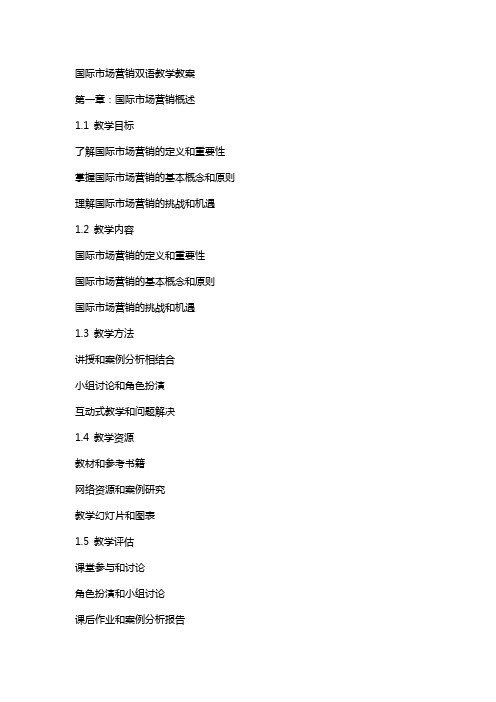
国际市场营销双语教学教案第一章:国际市场营销概述1.1 教学目标了解国际市场营销的定义和重要性掌握国际市场营销的基本概念和原则理解国际市场营销的挑战和机遇1.2 教学内容国际市场营销的定义和重要性国际市场营销的基本概念和原则国际市场营销的挑战和机遇1.3 教学方法讲授和案例分析相结合小组讨论和角色扮演互动式教学和问题解决1.4 教学资源教材和参考书籍网络资源和案例研究教学幻灯片和图表1.5 教学评估课堂参与和讨论角色扮演和小组讨论课后作业和案例分析报告第二章:国际市场营销环境2.1 教学目标了解国际市场营销环境的构成因素掌握国际市场营销环境的变化趋势理解国际市场营销环境的挑战和机遇2.2 教学内容国际市场营销环境的构成因素国际市场营销环境的变化趋势国际市场营销环境的挑战和机遇2.3 教学方法讲授和案例分析相结合小组讨论和角色扮演互动式教学和问题解决2.4 教学资源教材和参考书籍网络资源和案例研究教学幻灯片和图表2.5 教学评估课堂参与和讨论角色扮演和小组讨论课后作业和案例分析报告第三章:国际市场营销战略3.1 教学目标了解国际市场营销战略的制定过程掌握国际市场营销战略的基本要素理解国际市场营销战略的实施和评估3.2 教学内容国际市场营销战略的制定过程国际市场营销战略的基本要素国际市场营销战略的实施和评估3.3 教学方法讲授和案例分析相结合小组讨论和角色扮演互动式教学和问题解决3.4 教学资源教材和参考书籍网络资源和案例研究教学幻灯片和图表3.5 教学评估课堂参与和讨论角色扮演和小组讨论课后作业和案例分析报告第四章:国际市场营销产品策略4.1 教学目标掌握国际市场营销产品策略的基本要素理解国际市场营销产品策略的实施和评估4.2 教学内容国际市场营销产品策略的重要性国际市场营销产品策略的基本要素国际市场营销产品策略的实施和评估4.3 教学方法讲授和案例分析相结合小组讨论和角色扮演互动式教学和问题解决4.4 教学资源教材和参考书籍网络资源和案例研究教学幻灯片和图表4.5 教学评估课堂参与和讨论角色扮演和小组讨论课后作业和案例分析报告第五章:国际市场营销渠道策略5.1 教学目标了解国际市场营销渠道策略的重要性理解国际市场营销渠道策略的实施和评估5.2 教学内容国际市场营销渠道策略的重要性国际市场营销渠道策略的基本要素国际市场营销渠道策略的实施和评估5.3 教学方法讲授和案例分析相结合小组讨论和角色扮演互动式教学和问题解决5.4 教学资源教材和参考书籍网络资源和案例研究教学幻灯片和图表5.5 教学评估课堂参与和讨论角色扮演和小组讨论课后作业和案例分析报告第六章:国际市场营销传播策略6.1 教学目标理解国际市场营销传播策略的基本概念掌握国际市场营销传播策略的制定和实施方法6.2 教学内容国际市场营销传播策略的基本概念国际市场营销传播策略的制定和实施方法国际市场营销传播策略的有效运用6.3 教学方法讲授和案例分析相结合小组讨论和角色扮演互动式教学和问题解决6.4 教学资源教材和参考书籍网络资源和案例研究教学幻灯片和图表6.5 教学评估课堂参与和讨论角色扮演和小组讨论课后作业和案例分析报告第七章:国际市场营销价格策略7.1 教学目标理解国际市场营销价格策略的重要性掌握国际市场营销价格策略的基本要素学习国际市场营销价格策略的制定和评估7.2 教学内容国际市场营销价格策略的重要性国际市场营销价格策略的基本要素国际市场营销价格策略的制定和评估7.3 教学方法讲授和案例分析相结合小组讨论和角色扮演互动式教学和问题解决7.4 教学资源教材和参考书籍网络资源和案例研究教学幻灯片和图表7.5 教学评估课堂参与和讨论角色扮演和小组讨论课后作业和案例分析报告第八章:国际市场营销服务策略8.1 教学目标理解国际市场营销服务策略的基本概念掌握国际市场营销服务策略的制定和实施方法学习国际市场营销服务策略的有效运用8.2 教学内容国际市场营销服务策略的基本概念国际市场营销服务策略的制定和实施方法国际市场营销服务策略的有效运用8.3 教学方法讲授和案例分析相结合小组讨论和角色扮演互动式教学和问题解决8.4 教学资源教材和参考书籍网络资源和案例研究教学幻灯片和图表8.5 教学评估课堂参与和讨论角色扮演和小组讨论课后作业和案例分析报告第九章:国际市场营销风险管理9.1 教学目标理解国际市场营销风险的基本概念掌握国际市场营销风险的识别和管理方法学习国际市场营销风险的有效应对策略9.2 教学内容国际市场营销风险的基本概念国际市场营销风险的识别和管理方法国际市场营销风险的有效应对策略9.3 教学方法讲授和案例分析相结合小组讨论和角色扮演互动式教学和问题解决9.4 教学资源教材和参考书籍网络资源和案例研究教学幻灯片和图表9.5 教学评估课堂参与和讨论角色扮演和小组讨论课后作业和案例分析报告第十章:国际市场营销伦理和社会责任10.1 教学目标理解国际市场营销伦理和社会责任的重要性掌握国际市场营销伦理和社会责任的基本原则学习国际市场营销伦理和社会责任的最佳实践10.2 教学内容国际市场营销伦理和社会责任的重要性国际市场营销伦理和社会责任的基本原则国际市场营销伦理和社会责任的最佳实践10.3 教学方法讲授和案例分析相结合小组讨论和角色扮演互动式教学和问题解决10.4 教学资源教材和参考书籍网络资源和案例研究教学幻灯片和图表10.5 教学评估课堂参与和讨论角色扮演和小组讨论课后作业和案例分析报告重点解析本文档为“国际市场营销双语教学教案”,共包含十个章节。
国际市场营销(双语版)8.Place
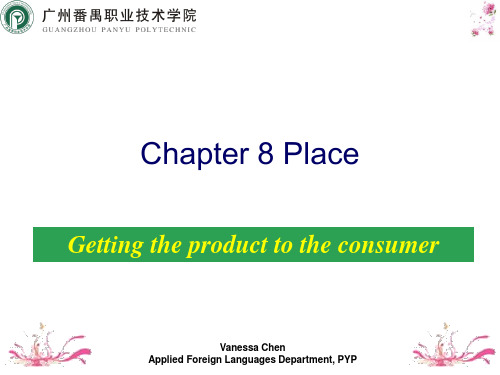
Intensive distribution: channel policy in which a manufacturer of a convenience product attempts to saturate the market
Selective distribution: channel policy in which a firm chooses only a limited number of retailers to handle its product line
Applied Foreign Languages Department, PYP
Marketing Channels for Consumer Products
Producer
Wholesalers Retailers
VCanoensssauCmheenrs
Applied Foreign Languages Department, PYP
短渠道
零阶渠道 一阶渠道
长渠道
二阶渠道 多阶渠道
Vanessa Chen Applied Foreign Languages Department, PYP
Marketing Channels for Consumer Products
Producer
VCanoensssauCmheenrs
Applied Foreign Languages Department, PYP
Vanessa Chen Applied Foreign Languages Department, PYP
渠道宽 窄比较
制造商
中间商1 中间商2 中间商3
……
目标市场
制造商
国际市场营销学第八版英文版

国际市场营销学第八版英文版International Marketing: 8th EditionAbstract:International marketing plays a crucial role in the global business landscape. It involves various activities and strategies aimed at expanding products and services into international markets. This article explores the key concepts, principles, and strategies of international marketing as discussed in the 8th edition of the book "International Marketing."Introduction:In today's interconnected world, businesses are increasingly looking towards international markets to expand their reach and increase profitability. International marketing involves the planning, implementation, and coordination of marketing activities across national boundaries to meet the diverse needs and preferences of global consumers. The 8th edition of "International Marketing" offers comprehensive insights into this dynamic field.1. Global Market Entry Strategies:International market entry strategies are vital for businesses aiming to establish a presence in foreign markets. This section explores several strategies, such as exporting, licensing, franchising, joint ventures, and direct investment. Each strategy has its benefits and challenges, and selecting the most suitable approach depends on factors like market characteristics, resources, and objectives.2. International Market Research and Analysis:Understanding the international marketplace is critical for successful market penetration. This segment emphasizes the significance of market research and analysis in international marketing. Topics covered include the identification of target markets, assessing market potential, consumer behavior analysis, and conducting competitive analysis. By utilizing these research techniques, companies can make informed decisions and tailor their marketing strategies accordingly.3. Global Product and Brand Management:Adapting products and brands to international markets is essential for success. This section covers the challenges faced in global product and brand management, including product development, standardization versus adaptation, and brand positioning strategies. With insights from the 8th edition, businesses can effectively manage their product and brand portfolios across diverse cultures and markets.4. International Pricing Strategies:Pricing is a critical element in international marketing as it directly influences market acceptance and profitability. This segment explores various pricing strategies, such as cost-based pricing, market-based pricing, and competitive-based pricing. The 8th edition highlights the importance of considering factors such as local market conditions, currency exchange rates, and cost structures when determining international pricing strategies.5. Global Distribution and Supply Chain Management:Efficient distribution and supply chain management are essential for delivering products and services to international customers. This section addresses topics such as channel selection, logistics management, and transportation strategies. The 8th edition provides insights into the complexities and challenges of managing global distribution networks.6. International Marketing Communications:Effectively communicating with consumers in diverse cultural contexts is crucial for international marketing success. This segment examines the intricacies of international marketing communications, including advertising, public relations, sales promotions, and personal selling. The 8th edition highlights the importance of cultural sensitivity, language adaptation, and media selection in international marketing communications.7. Ethical and Sustainable International Marketing:The 8th edition delves into the ethical and sustainable aspects of international marketing. It covers topics such as fair trade, social responsibility, and green marketing. In an era of increased environmental consciousness and social awareness, businesses must consider these factors when formulating their international marketing strategies.Conclusion:The 8th edition of "International Marketing" provides valuable insights into the intricacies and dynamics of global marketing. By understanding the concepts, principles, and strategies discussed in this book, businesses can navigate the complexities of international markets and achieve success in their global endeavors. International marketing continues to evolve, and theknowledge shared in this edition paves the way for businesses to excel in an increasingly interconnected world.。
04878_国际市场营销双语教学教案ppt课件
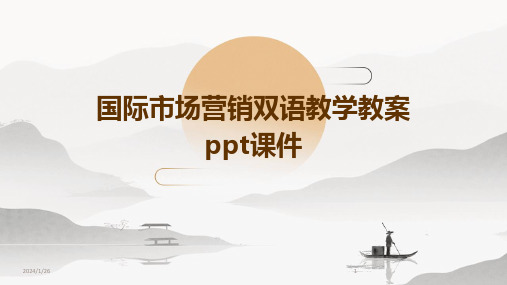
2024/1/26
1
目录
• 课ቤተ መጻሕፍቲ ባይዱ介绍与教学目标
• 国际市场营销基本概念与理论
• 跨文化交流与沟通在国际市场营销中应用
• 产品策略在国际市场营销中实践
• 价格策略在国际市场营销中运用
• 渠道策略在国际市场营销中拓展
• 促销策略在国际市场营销中创新
• 总结回顾与展望未来发展趋势
16
04
产品策略在国际市场营销中 实践
2024/1/26
17
产品定位与差异化战略
产品定位
根据目标市场需求和竞争态势, 明确产品在市场中的定位,包括 产品特点、目标消费者群体、价
格策略等。
2024/1/26
差异化战略
通过独特的产品设计、功能、品质 、服务等方面与竞争对手区分开来 ,形成独特的竞争优势,提高市场 份额和盈利能力。
8
国际市场营销环境分析
01
02
03
04
政治环境
分析目标国家的政治稳定性、 政策连续性、对外关系等因素
。
经济环境
研究目标国家的经济发展水平 、市场规模、消费者购买力等
。
社会文化环境
了解目标国家的文化传统、价 值观念、消费习惯等。
技术环境
关注目标国家的技术发展水平 、创新能力和知识产权保护等
。
2024/1/26
2024/1/26
27
电子商务平台利用和整合
2024/1/26
电子商务平台选择
根据产品特性和目标市场,选择合适的电子商务平台,如亚马逊 、阿里巴巴等。
线上线下融合
将线上电子商务平台与线下实体店相结合,实现O2O模式,提高 消费者购物体验和品牌认知度。
第二章国际市场营销双语
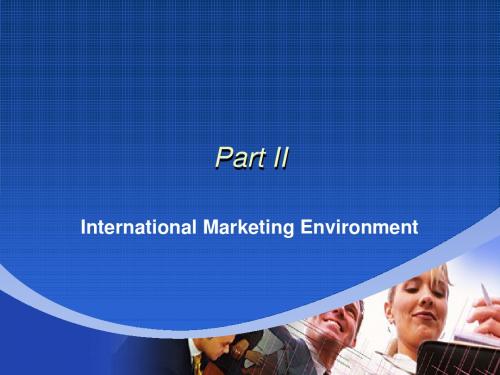
• 贸易争端的解决方式
2.2.1国际市场营销的法律环境因素
• 对企业来讲,法律环境就是“商业游戏”的竞争规则。 • 国际营销所面临的法律包括三个方面: ①与国际营销有关的国内法律; ②国际性法律与组织; ③国际营销面对的国外法律体系。
2.2.2 国际法律环境
• 1.国际贸易相关立法 贸易壁垒 技术性贸易壁垒 反倾销
2.1.1 Political Environment Factors influencing International Marketing 2.1.2 Influence of Political Environment on International Marketing 2.1.3. Forecasting and Reducing Political Risks • 国际市场营销的政治环境 因素
• 国家间关系 • 民族主义:
• 民族主义是一种意识形态。这 种信念是建立在国家、种族的 划分和民族同一性基础上的。
•
可 口 可 乐 汇 源 收 购 案
2. Domestic Political Environment
① ② ③ ④ ⑤ 政治制度 政治稳定性 政策连续性 行政干预 行政效率
2.1.2 政治环境对国际市场营销的影响
• 政治环境对国际市场营销 的影响 • 政治风险的预测及防范
1. International Political Environment • 1. International Political Situation • 2. States Relations • 3. Nationalism • 国际政治局势
• 进入风险 • 经营风险 没收(Confiscation) 征用(Expropriation) 进口限制(Import Restrictions) 税收控制(Tax Controls) 价格控制(Price Controls)
- 1、下载文档前请自行甄别文档内容的完整性,平台不提供额外的编辑、内容补充、找答案等附加服务。
- 2、"仅部分预览"的文档,不可在线预览部分如存在完整性等问题,可反馈申请退款(可完整预览的文档不适用该条件!)。
- 3、如文档侵犯您的权益,请联系客服反馈,我们会尽快为您处理(人工客服工作时间:9:00-18:30)。
Getting the product to the consumer
Vanessa Chen Applied Foreign Languages Department, PYP
教学目标
Understand the definition of distribution channel, and its structure 掌握分销渠道的概念及类型
Wide and narrow
密集型分销 Intensive Distribution
选择分销 Selective Distribution
独家专营 Exclusive Distribution
Vanessa Chen Applied Foreign Languages Department, PYP
Intensive distribution: channel policy in which a manufacturer of a convenience product attempts to saturate the market
Selective distribution: channel policy in which a firm chooses only a limited number of retailers to handle its product line
Vanessa Chen Applied Foreign Languages Department, PYP
渠道宽 窄比较
制造商
中间商1 中间商2 中间商3
……
目标市场
制造商
中间商1 中间商2
…… 中间商n (n有限)
目标 市场
制造商
中间商
Vanessa Chen
目标 市场
Applied Foreign Languages Department, PYP
Explain the differences 熟悉批发商和零售商的职能和类型
Design and manage the marketing channel 掌握分销渠道设计的基本策略
Vanessa Chen Applied Foreign Languages Department, PYP
Vanessa Chen Applied Foreign Languages Department, PYP
Marketing Channels for Consumer Products
Producer
Agents or brokers
Wholesalers
Retailers
Consumers Vanessa Chen Applied Foreign Languages Department, PYP
Vanessa Chen Applied Foreign Languages Department, PYP
商流
物流
五流 合一
促销 流
货币
信息
流
流
Vanessa Chen Applied Foreign Languages Department, PYP
Types of distribution channels
安利 厂家直销员
日用工业 品厂商
消 费 者
雅芳
自办零售店
消 费 者
Vanessa Chen Applied Foreign Languages Department, PYP
Marketing Channels for Consumer Products
Producer
Retailers CVaonensssua mCheenrs
Short vs. Long Wide vs. Narrow
Conventional vs. Integrated
Vanessa Chen Applied Foreign Languages Department, PYP
Long and short
1.长度不同的渠道 分销渠道的长度是指商品在整个流通过程 中经过的中间层次的多少 。
Applied Foreign Languages Department, PYP
Marketing Channels for Consumer Products
Producer
Wholesalers Retailers
VCanoensssauCmheenrs
Applied Foreign Languages Department, PYP
短渠道
零阶渠道 一阶渠道
长渠道
二阶渠道 多阶渠道
Vanessa Chen Applied Foreign Languages Department, PYP
Marketing Channels for Consumer Products
Producer
VCanoensssauCmheenrs
Applied Foreign Languages Department, PYP
16
LEVELS OF DISTRIBUTION INTENSITY
Intensity Level
Objective
Number of Intermediaries
Intensive
Achieve mass market selling.
Convenience goods.
Selective
Work with selected intermediaries.
Shopping and some specialty goods.
Exclusive distribution: channel policy in which a firm grants exclusive rights to a single wholesaler or retailer to sell its products in a particular geographic areaFra bibliotek零阶渠道
(1)零阶渠道 ①直接销售(direct selling)
上门推销、办公室推销、家庭销售会、寄放 销售、多重传销 ②直效营销(direct marketing)
电视直效、互联网直效、电话直效、电台直 效、报纸直效 ③厂家自办店
Vanessa Chen Applied Foreign Languages Department, PYP
